S and P final
1/80
There's no tags or description
Looks like no tags are added yet.
Name | Mastery | Learn | Test | Matching | Spaced |
|---|
No study sessions yet.
81 Terms
Forced-choice preferential looking and Contrast sensitivity of infants
experiment to measure infants' perception and if they could differentiate grating from a homogeneous region. The researchers used bars of grating and made the bars more narrow until the infant changed attention, there was no one way to know if the infant was still truly looking at the grating. Adults would have to indicate if the infant was looking at the stimuli or not, that is why it is called forced-choice. This experiment allowed researchers to see how the ability of contrast sensitivity changes over time and how it matures from a young age. This experiment also helped researchers understand the visual acuity and sensitivity of infants when looking at different stimuli. I believe this also goes back to the nature vs nurture question of whether are we born with these abilities or did we learn them.
Nature-nurture question-
to address this question, a study was conducted on infants to see if the infants naturally perceived patterns and grating from a plain surface.
Effect of restricted rearing on kitten’s visual -
Astigmatism, Reduced Visual Acuity: Visual acuity refers to the clarity or sharpness of vision. Abnormal Visual Processing, Impaired Depth Perception, Altered Visual Preferences, and Behavioral Changes
development(stripped drum experiments)-
Kittens were raised in an environment where their visual experience was restricted to specific patterns.
Kittens were placed in a drum that was lined with either vertical or horizontal stripes during a critical period of visual development.
Findings:
-Receptive fields: orientations matched that of the drum in which the kitten spent early weeks.
-Behavior: kittens seemed to ignore objects whose orientation did not match those of the drum in which they spent their early weeks
this showed a deficiency in their ability to perceive horizontal lines later in life, and vice versa. This suggested that the visual experience during the critical period had a profound impact on the development of orientation-selective cells in the visual cortex.
- Astigmatism: Astigmatism refers to unequal visual acuity for different orientations. It is caused by the cornea not being fully spherical. As a result, horizontals are imaged with less blur than verticals, or verticals imaged with less blur than horizontals. Astigmatism is easily correct by glasses or contact lenses.
astigmatism does not affect both eyes equally.
Stryker's experiments(Blind experimenter; random sampling)-
Stryker (1978): reared kittens in striped drums using methods designed to limit possible biases on the part of the researchers.
“Blind” experimenter: the person doing the recording of neural activity does not know whether the kitten was raised in a drum with vertical or horizontal stripes.
Random selection of which cells to record. This is important to be sure that neurons in different locations of V1 are studied.
Results: When sources of bias are removed, Stryker found no change in V1 neurons as a result of the exposure to the drums
Stryker later experiments
What if each eye sees a DIFFERENT view of the world?
Results: After spending time with these goggles, there were major changes in V1. All neurons were monocular (not binocular)( binocular cues require comparisons of information across the two eyes, and monocular cues include information available to a single eye) and responded only to the orientation (H or V) seen by the eye (right or left) they were responsive to.
Early experience in which the two eyes do not have equivalent views of the world can cause permanent changes to V1.
Consequences:
1. Amblyopia: one eye has better visual acuity and contrast sensitivity than the other. The amount of the difference can range from a little to a lot.
2. Loss of stereopsis: inability to use disparity as a cue to depth (we use disparity as a cue to depth to see the shapes in depth in the stereograms)
3. Loss of binocular disparity tuned neurons (the difference between the two eyes' images, is a powerful cue to generate the 3D depth percept known as stereopsis")
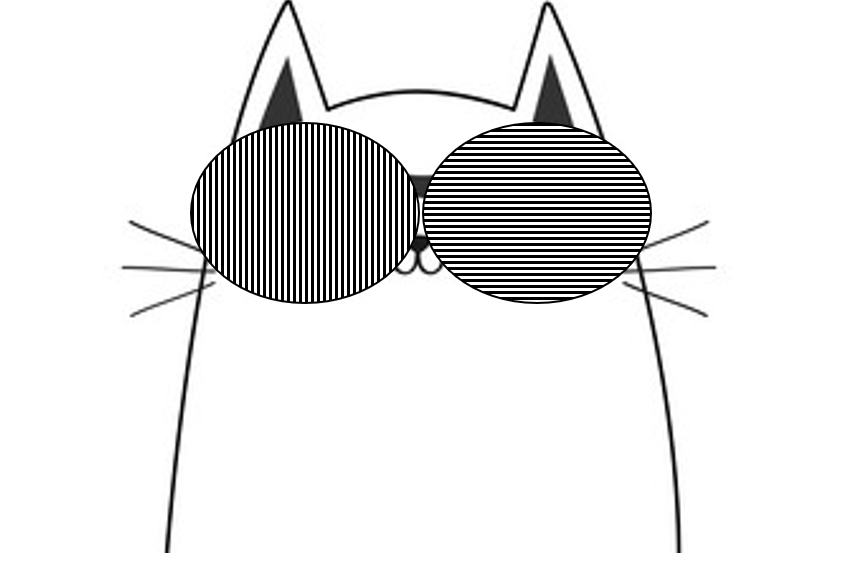
Perceptual learning in adults-
Extensive practice with different visual tasks can produce improvement that last month or years.
Karni and Sagi’s sleep deprivation experiments-
two groups of subjects, one group was deprived of rapid eye movement sleep(REM), and the other was deprived of nonrapid eye movement sleep(REM). Overnight learning only occurred in those who experienced REM sleep. Karni concluded that REM sleep helps consolidate and solidify the memory traces of events experienced while awake.
Video games and perceptual learning-
researchers wanted to learn about how doing external visual tasks can enhance someone's perceptual learning in adults. They found that adults who played video games scored better at measuring contrast sensitivity grating compared to people who did not play video games. The point of the experiment was to see the visual attention of the video game players and how videos like Call of Duty require the player to pay close attention and have the ability to navigate through puzzles, spatial reading, and shape identification. These repetitive skills gave the individuals the ability to improve their visual functions.
Corresponding points-
a point on the left retina and a point on the right retina that would coincide if the two retinas were superimposed - for example, the foveas of the two eyes
Horopter-
retinal images fall on corresponding retinal points, the corresponding retinal points are located right of the fovea and they can all line up if you were to place your two eyes on top of one another
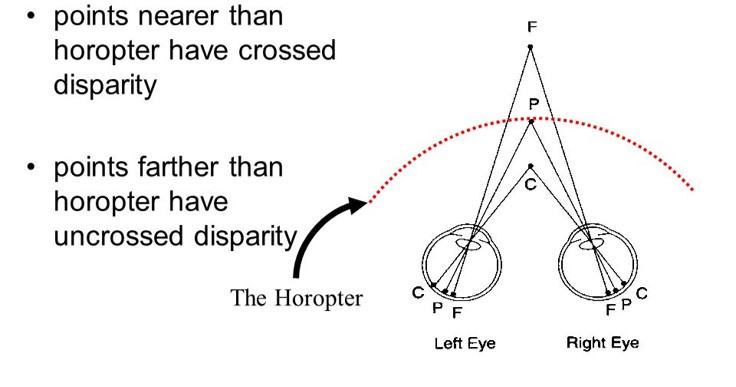
Disparity(crossed and uncrossed)-
Uncrossed disparity: An object farther away from you than the horoptor has uncrossed disparities. You'd have to uncross (diverge) your eyes to fixate on it. It lies further to the right from the right eye's viewpoint than from the left eye's viewpoint.
Crossed disparity: An object closer than the horoptor has crossed disparities. You'd have to cross (converge) your eyes to fixate on it. It is further to the left from the right eye's perspective.
Stereopsis: using disparity as a cue to depth-
the ability to use disparity as a cue to depth, the demo with the red and blue three d glasses. One eye gets the red dots and one gets the green, your disparity-tuned neurons are recognizing this but are getting fooled because the dots are on no corresponding points.
Disparity-tuned neuron-
these neurons help us understand the perception of depth and 3D space in our environment. It is almost life and death, understanding where something is in comparison to where we are helps us make decisions on what direction to go. Depending on which neuron the stimuli hits will determine which neuron fires. These cells are found in the visual cortex and respond to different visual information in both eyes. These neurons help us adjust to changes in binocular disparity to maintain a consistent perception of the object's properties.
Random dot stereogram-
autostereogram that uses randomly generated patterns to create a 3D image when viewed correctly. It relates to sensation and perception by demonstrating how our brain processes visual information to perceive depth and three-dimensional objects. When we view these stereograms, each eye receives a slightly different pattern, and our brain combines these two images to create the perception of depth, showcasing how sensation (the input of visual stimuli) and perception (the brain's interpretation of that stimuli) work together to construct our visual experience.
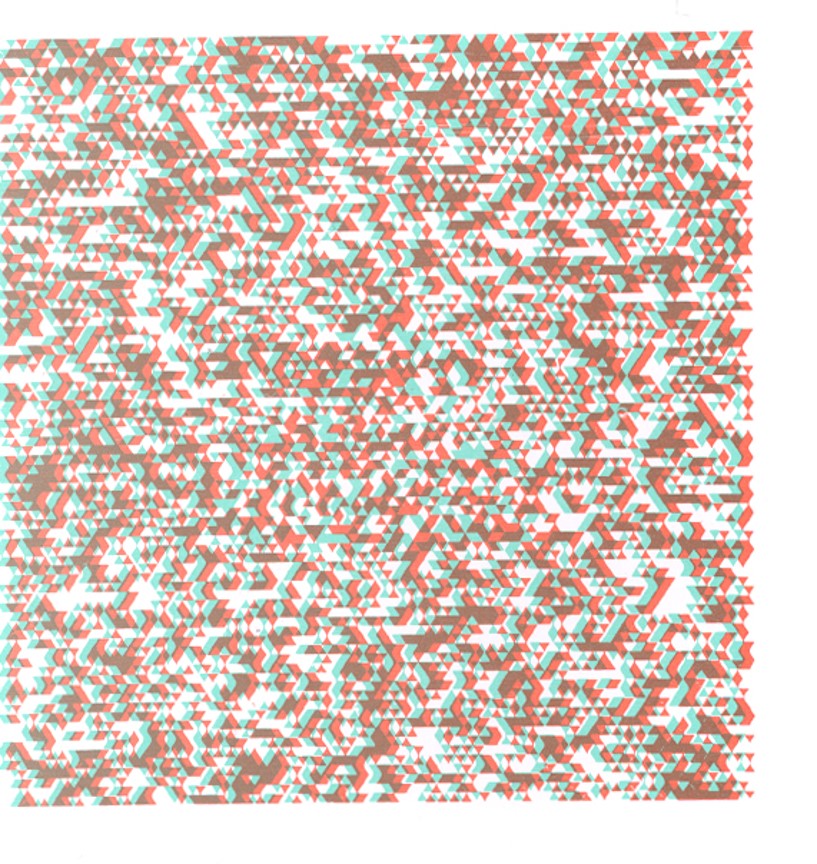
Effect of Strabismus and congenital cataract on binocular vision and binocular neurons-
strabismus and congenital cataracts can cause Amblyopis, which can inhibit binocular vision and binocular neurons because one eye will see contrast and visual acuity better in one eye compared to the other. Binocular vision requires both eyes to be at optimal functionality so that our brain can preserve different viewpoints to estimate depth and contrast. Having our binocular neurons impaired can possibly lead to disparities in motion perception and overall perception.
Amblyopia-
difference in visual acuity or contrast sensitivity in the two eyes. One eye sees better than the other
Bayesian theory of cue combination:
use all the cues but give the greatest weight to the most reliable cues
What vs. Where system-
involving the perception of motion, the y ganglion cells are sent to a set layer of LGN called the magnocellular layer. These cells respond on the basis of the motion of the stimulus or its location depth.

Motion detector-
The motion detector cells respond on the basis of the direction of motion and the direction of the motion affects the firing rate of the neurons. A study was done on primates to see how motion would affect their neuron's response. Primates have a neuron called MT and it is loaded with motion detectors. Research found that these neurons preferred motion in one direction and the detectors can only respond if one direction gives off more of a signal than the other(a difference in the firing rate of L and R). These neurons prefer a stimulus moving from left to right due to a delay in the pathway of L, so the stimulus will hit the level 2 neuron at the same time as when the R pathway hits the level 2 neuron. These motion detectors help us organize sensory input from our environment so we can navigate through safely.

Motion aftereffect
motion aftereffect has to do with fatiguing the motion detectors by viewing motion in different directions and having the brain try to figure out what is going on. We did a demo in class that illustrated this effect by having our motion detectors stare at a moving circle for a select amount of time and then we were able to see motion where there was none. Our exposure to the moving circle caused our visual systems to be overwhelmed and caused them to adapt to what we were perceiving. This showed that our visual systems can be influenced by external stimuli and we can perverse things that are not there.
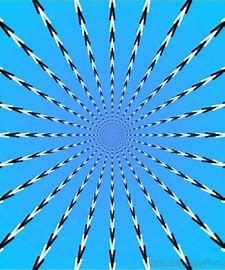
Neural adaptation-
after viewing motion in a given direction for many seconds, the directionally selective neurons that respond to motion in that direction begin to fatigue and fire at a lower rate.
Direction selectivity-
Barlow and Hill found that ganglion cells in the rabbit responded well to motion. When you introduce a second neuron, you will have a delay because they are directly selective. In primates, the directionally selective neurons are found in V1, and in Area MT, there is a center surrounding organization, meaning these cells respond best to motion moving in opposite directions. A stimulus moving from left to right delivers a big input to our level 2 neurons. The level 2 neurons respond better to motion from left to right than to motion from right to left.
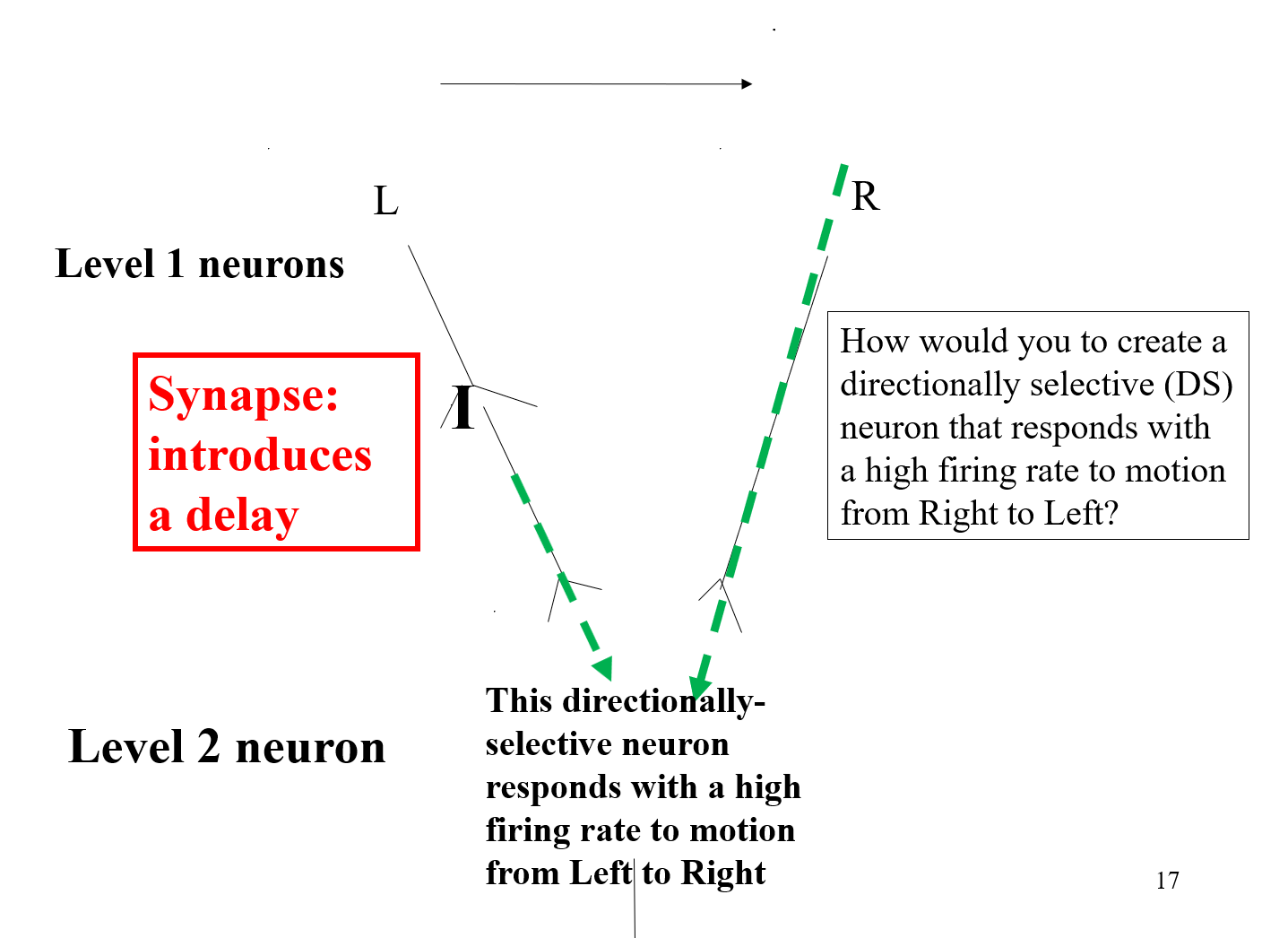
Center-surround organization-
some of the receptive fields in MT show this. The neuro below fires with a high rate to a stimulus moving to the left provided the stimulus is in the center of the receptive field. It responds with a high rate to a stimulus moving to the right provided that the stimulus is in the surround of the receptive field.
Apparent motion-
DEMO- nothing is really moving, it is the secretion of stationary images. If the time between jumps is short you can see motion when technically all you have are jumps.
Aperture problem-DEMO-
location level, square moving back and forth diagonally, but when you look at certain sections you can see that the motion is up and down. Motion-detecting cells will respond to motion no matter what, so when presented with the Aperture problem, the cells will respond to where they think the motion is going even if it is in the wrong direction. In each aperture, there is motion going in every direction.
Global motion
another cell that is possibly an MT that is getting signals from all the motion detectors when they are presented with the aperture problem, and these cells take a vote on what the true motion is. Tells us when we see all four motions, well see it go down to the right.
Optic flow-DEMO-
The changing angular positions of points in a perspective image that we experience as we move through the world(moviews use this to make it seem like we’re moving forward)
Motion-defined-form-DEMO
flying bird, without motion there is no shape, when the bird starts to move you can see the outline of the bird through the scattered lines.
Motion-in-depth-
combines perception of motion and binocularity.
Smooth pursuit eye movement-
The eyes smoothly follow a moving target
Biological motion-DEMO-
you dont need to see much, all you need to see is the pattern of a person/living things. Detects pattern of motion consistent with the pattern of living things.
William James-
believes attention is the possession by the mind, in clear and vivid form, of one out of what seems several simultaneously possible objects or trains of thought.
Passive vs. active attention-
Passive involves a more effortless or involuntary focus on something. It occurs when our attention is drawn to stimuli without deliberate effort or conscious control. For instance, when you're watching TV and the commercials suddenly grab your attention, that's a form of passive attention. Similarly, scrolling through social media and pausing at an intriguing post without actively intending to focus on it demonstrates passive attention. Active is a more intentional and conscious form of focus. It involves purposefully directing your mental energy toward a specific task or stimulus. When you're studying, solving a problem, or engaging in a conversation where you actively listen and participate, that's active attention at work. It requires conscious effort and concentration.
Attention to objects vs. attention to ideas
Attention to objects involves directing focus towards physical entities or tangible things in the environment. Attention to ideas involves engaging with abstract concepts, thoughts, or mental constructs.
Cocktail party phenomenon
it is possible to have a one-to-one conversation in a loud room with many other conversations in the background. They had two messages playing, one in each ear, then they asked what message was said in each ear. Demonstrating that you can select one stream of information. Later on, in time, the researchers had their names said in one ear, the person then changed their attention to the other ear. So, when you're not paying attention to something it does not mean the messages are not getting through.
Attention and Contrast Sensitivity-
an attempt by Dosher and Lu, does attention affect perception? Looking ahead, and paying attention to things on the side. Valid trail, arrow, and carrot pointing in the same place, and the invalid trailer where you need to report where your attention is not. They wanted to know if you do better in valid trials where you report where your attention is directed. So they expect that you will do better in the valid trailers if attention affects perception. In some trailers, the gratings were covered in dots making them harder to see. Performance gets better with contrast, but it doesn't matter whether you reporting where you attending or somewhere else. But when the dots were there, that's when attention mattered, you did better when reporting where you attending. They conclude that attention makes things stand out better from surrounding stimuli.
Attention in neural area MT(Treue and Maunsell experiment)-
they trained monkeys to pay attention to dots to see the firing rate of the upward dot and the downward dot alone. Attention to the dot moving down was the cell's preferred direction of motion and the dot moving up was when the cell hardly responded. The response of the cell only depended on the dot that was attended. The presence of another dot in the receptive field did not influence the firing of the neuron if it was not attended to. This demonstrated that attention had a selective and modulatory effect on neural responses in Area MT.
The results of this study supported the idea that attention plays a critical role in shaping neural processing, emphasizing the selectivity of attention in enhancing the processing of specific information while suppressing irrelevant information.
fMRI: attention to faces vs. places-
when our eyes focus on either the house of the face or the areas of our brain that precisely the stimulus is related to the object we decide to focus our attention on. The importance of this experiment was to show that attention does have an impact on memory and can make certain objects or sounds stand out more than others. What we focus on is what we perceive. This is also important because it supports the theory that attention acts to make objects stand out from other surrounding objects.
Multitasking, attention and cell phones
Increases reaction time to important events
2. impairs ability to notice objects in the environment
3. increases rate of accidents
Research has shown that even though it often feels as if we can multi-task, there is almost always some loss in performance when we try to attend to two things at once

Scene Perception
The question is, how can our brains perceive a scene with such detail so quickly? Scene layout helps our brains throw out non-important information and attach meaning to important information quickly from our environment. We need this in our day-to-day because our perception of our environment helps us organize information so we can take in what is relevant to our survival in that situation.
Perception of individual detail
sensation is the starting point. For instance, in visual perception, individual details are gathered through the detection of light and shapes by the eyes. However, the brain's role in perception is crucial here. It takes these individual sensory inputs and organizes them, filling in gaps, recognizing patterns, and making sense of the information
Scene layout or gist
the “layout” or “gist” of a scene can be determined using information available in V1, specifically, the activity of neurons sensitive to different orientations at different spatial scales.
Another way of saying this is to say that scenes can be classified into broad categories based on cues available in early vision. You don’t need information about the identity of specific objects.
The term "scene layout" or "scene gist" refers to the perceptual and cognitive representation of the overall structure and meaning of a visual scene. It involves the rapid extraction of essential information about the arrangement and identity of objects in a scene, allowing individuals to form a quick and coarse understanding of their visual environment. This concept is essential for visual perception and plays a crucial role in how we interpret and interact with our surroundings.
Oliva and Torralba's theory of scene perception-
they wanted to know how the rapid organization and recognition of scenes based on primitive characteristics like lines and depth in V1 could set off cues to classify scenes and objects in our brain. They realized there were ways they could categorize how our brains perceived these scenes. Acuity, crowding, and memory; acuity and crowding, their theory concludes that even under low-resolution or crowding when viewing a scene, our visual system can still adapt quickly to extract the layout of the scene.
Acuity and crowding-
Acuity is when we look at fine details, the further it gets away from us the harder it is to see the fine details. Crowding indicates the issues our brains have trying to see details when there are several objects around the object we are trying to focus on.
Memory for objects in scenes-
visual memory is limited so that we are constantly having to look back again to remind ourselves what was there in the image
Mechanical energy-
sound travels by the movement of particles. A sinusoidal sound wave is also called a pure tone. Longitudinal waves are the sound going from the sound to the ear in a perpendicular motion.
Compressions; rarefactions-
highs and lows of waves traveling through the air
Pure tone-
can vary in amplitude, and pure tones are sinusoidal, some frequencies we are more sensitive to than others
Sinusoid: frequency, amplitude-
The rate at which regions of high and low pressure pass through a given location in space is the frequency of the tone, , the higher the amplitude the louder the sound
Fourier analysis-
any complex sound is equivalent mathematically to set a of pure tones
Decibel-
20 times the log of the sound pressure divided by the sound pressure. Which is the absolute threshold
Equal loudness curves-
depends on the frequency and its amplitude, all tones on a given line sound equally loud, graph sensitivity is greatest lower on the graph
Outer ear
pinna(ear lobe) and auditory canal
Inner ear
contains the cochlea, cochlea is a fluid field region.
Middle ear
contains 3 bones: malleus, incus, and stapes, the bones in the middle ear are there to transmit the sound and compression it to a small region
Malleus, incus, stapes
name the 3 ossicles of the ear
cochlea
The cochlea is a fluid-filled, spiral-shaped cavity found in the inner ear that plays a vital role in the sense of hearing and participates in the process of auditory transduction.
basilar membrane of cochlea
The basilar membrane is inside the cochlea which is part of the inner ear and it helps distinguish the frequency of tones when the sound energy hits the cochlea and vibrates the basilar membrane. Different frequencies will vibrate the membrane differently based on the strength of the stimulus and are more sensitive to low-frequency tones. In conclusion, the basilar membrane tells the brain about different auditory sensations based on physical stimuli that vibrate the membrane based on the intensity of the tone.

tectorial membrane
A membrane located above the basilar membrane; serves as a shelf against which the cilia of the auditory hair cells move
inner hair cells
Hair cells in the inner ear are vital sensory receptors responsible for auditory transduction. These specialized cells detect and convert mechanical vibrations induced by incoming sound waves into electrical signals that can be interpreted by the brain as sound
outer hair cells
The outer hair cells are primarily involved in amplifying the vibrations of the basilar membrane, a crucial step in the enhancement of auditory signals, contributing to the ability to hear faint sounds and discriminate between different pitches.
Transduction-
conversion of one form of energy into another. In sensation, the transforming of stimulus energies, such as sights, sounds, and smells, into neural impulses our brains can interpret.
Neurons in auditory nerve
The firing pattern of neurons has to do with the stimulus's frequency, intensity(place theory), and timing(time theory). Depending on which neurons are firing will determine the pitch. There are different areas of the basilar membrane such as the base and the apex, the apex responds best to low-frequency tones(meaning it takes a lower intensity to get these neurons to fire) and the base responds best to high-frequency tones.
Place code (place theory)
the process by which different frequencies stimulate neural signals at specific places along the basilar membrane, from which the brain determines pitch
Temporal code(timing theory)
the cochlea registers low frequencies via the firing rate of action potentials entering the auditory nerve
Phase locking
Firing of auditory neurons in synchrony with the phase of an auditory stimulus.
Hearing aids
electronic devices that are worn to correct a hearing loss
Speech spectrogram
a depiction of the physical acoustic energy of an utterance by plotting frequency in hertz or cycles per second on the y-axis and time in milliseconds on the x-axis. and the color represents Amplitude (red highest, blue lowest) Applies to the Fourier theorem, speech is a complex tone, not a pure tone

Phoneme
This is the basic unit of speech and certain syllables exaggerate the vocal chords resulting in a vibration. Every syllable has a different frequency and duration of time. Our auditory system detects these vibrations too and our brain interprets the sound to form something we can understand, so then we can communicate.
Voice-onset time and infantes
This time delay represents the delay in the onset of “voicing”, where voicing refers to the vibration of the vocal chords
These graphs show the rate of sucking over time, VOT was changed at the dashed vertical line. For the graph on the left, the change in VOT crossed the category boundary. Graph on the right no change. The increased rate of sucking meant that the infant detected the new sound. Infant heard new speech sound only when the change in VOT crossed a category boundary; same as the adults.

Formant and Second format transition
The first format is the same for each, the second format differs in what is called the second format transition. For the stimulus labeled 1(upper left), the frequencies in the second format transition lessens as we move to the right across the graph, until for sounds 7 and then 8 the frequency of the second formant hardly changes at all over time. For sounds 11 -14, the second formant decreases over time. This is from Liberman

Categorical perception of speech
Categorical perception of speech can be altered based on the categorical boundaries crossed which can change the way you perceive sound, otherwise, if the boundary is not crossed the level of perceived sound is at a baseline. The categorical boundaries that can be crossed to change the perceived sound are there to help us understand the speed at which the sound reaches our ears and how we can differentiate different sounds from the desired sound
Categorical perception in infants and in chinchillas
Infants preserve sound the way adults do; the infants were able to detect a sound that was different from the one they had been listening to. The duration of time the infants had been listening to certain sounds affected how the infant responded later to different languages. Infants who are exposed to multiple languages at a young age have a higher chance of retaining the information because of their ability to recognize different sounds like transitions in tone and fluctuating levels of frequency. It can also be examined in other species like chinchillas. The chinchillas associated certain syllables with the cue to drink water, meaning that other creators can use categorical perception to induce or retract behavior.
Speech perception for native vs. other languages-
Different languages have different category boundaries. So the category boundaries that develop for the native language won't necessarily be suitable for other languages. This means that the 1-year-old ( and the adults) will not be able to make certain distinctions among speech sounds that are important in other languages. Perceptual distinctions among speech sounds that native speakers can make easily might not be possible by non-native speakers. Infants that had been exposed to different languages between 10 and 12 months, were able to distinguish between tones in other languages.

McGurk effect
it occurs when what we see( visual information of speaker's lip moving) conflicts with what we hear(auditory information a spoken sound), leading to a perceptual fusion of both inputs. If someone says "ba" but their lip movement appears to be saying "ga", you might perceive the sound as something in-between, like "da". This demonstrates that our perception is not solely reliant on one sense (hearing) but rather a complex interplay between different sensory inputs.
Goldstone and Hendrickson
reviewed categorical perception in speech and other perceptual domains and concluded that categorization of what we perceive was important for linking perception to behavior
Labeled line theory vs Intensity pattern theory -
there are different nerves for pain and itch, intensity/pattern theory - the same nerves control pain and itch, but they have different firings to distinguish between them
Bishop Berkely's "touch teaches vision"-
Derived from Empiricism, we start from knowing nothing and grow our understanding by making associations. For example, babies dont know the world is 3-D until they touch a lot of things, make mental connections, and learn.
Descartes innate idea
the concept that we are born with certain beliefs and knowledge, and we trust our senses = related to how Berkeley was wrong with the tepid water problem because we know from when we are born that solid and melted wax are both waxes, even though the same item can be two different things
Habituation method
the speech perception in infants, in the graph you can see a gap in time between the vocal cords moving when saying ba and pa(second graph). After the gap, that is the beginning of the vocal cords vibrating. Pa has a delay
